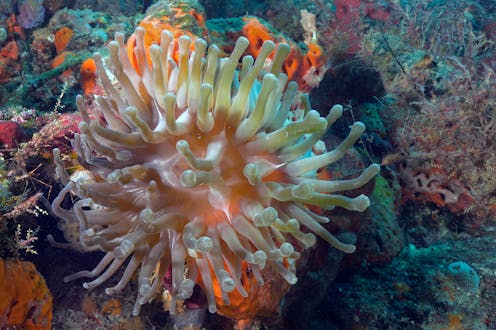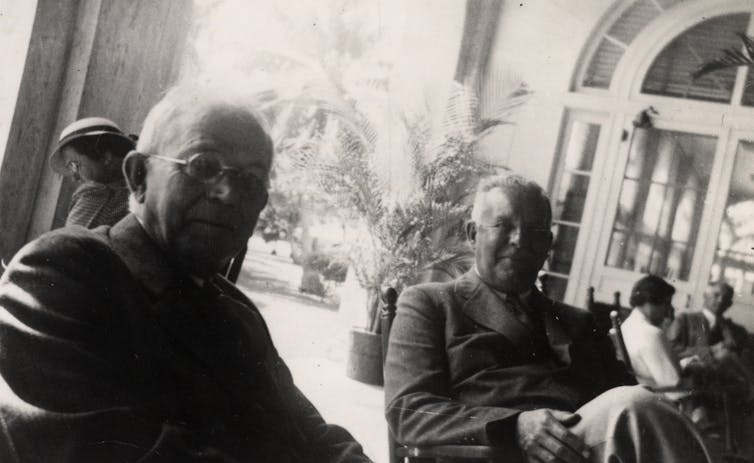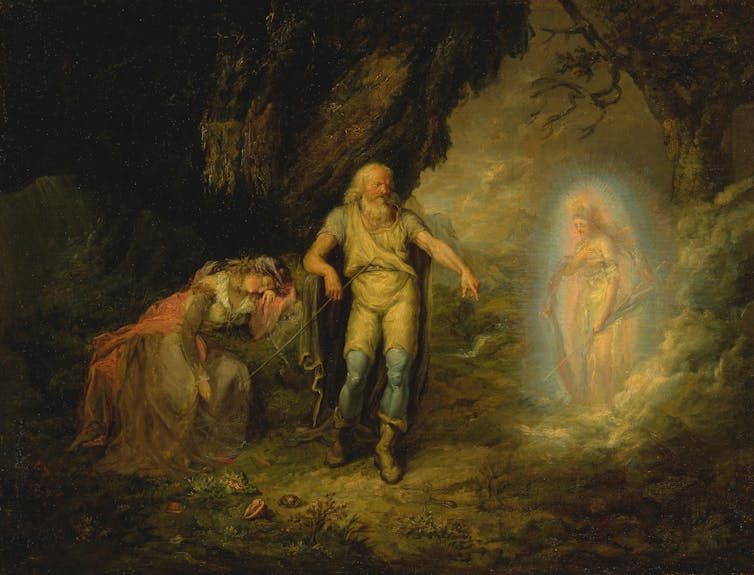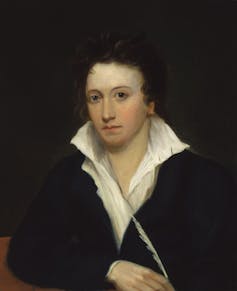
A word is dead
When it is said,
Some say,I say it just
Begins to live
That day.– Emily Dickinson
If someone asked you how you felt and you said you had “a sense sublime of something far more deeply interfused, whose dwelling was the light of setting suns, and the round ocean, and the living air”, your response would be greeted as strange or affected, to say the least.

Reading these famous lines from William Wordsworth’s Lines Written a Few Miles above Tintern Abbey as poetry, on the other hand, is a conscious activity requiring a different type of concentrated commitment. It requires an embrace of that strangeness, so as to become creatively receptive to the words as poetry.
This is the commitment that Wordsworth’s friend Samuel Taylor Coleridge called “the willing suspension of disbelief for the moment, that constitutes poetic faith” – with the emphasis on willing.
It happens every time we read (not just poetry, also novels), every time we see a painting, every time we hear music as music and not just as sound: we suspend our disbelief and enter into creative conversation.
Before and after
I want to take as an example Wallace Stevens’ The Idea of Order at Key West (1934), a high-modernist lyric that, arguably like all the best poems, looks before and after.
Less well known to an Australian audience than T.S. Eliot, his US compatriot and junior by nine years, Wallace Stevens was born in Reading, Pennsylvania, in 1879. He studied (like Eliot) at Harvard and later became an attorney.
In 1916, Stevens joined the Hartford Accident and Indemnity Company in Hartford, Connecticut, where – notoriously for the bohemian world – he rose to the rank of vice president and remained until his death in 1955. The possibly apocryphal story goes that his colleagues in the insurance industry, when they were asked about his poetry at his funeral, had no idea that “Wally” wrote poems.
Stevens’ uneventful life was punctuated by occasional cherished visits to Key West, an island in the Straits of Florida, surrounded by ocean and gazing towards Cuba to the south and the Bahamas to the east.
Not surprisingly, given its beauty and vulnerability, Key West becomes the site of one of poetry’s most enchanting reflections on the role of the imagination and art, as the speaker, having overheard a woman singing by the ocean, responds with a song-like meditation of his own.
The poem’s formal but flexible, and always musical, iambic pentameter – as so often in poetry in English, the metre of each line contains five feet, each with an unstressed syllable followed by a stressed syllable – looks back through the rhapsodic poetry of Walt Whitman and the major lyrics of Romantic poets, like Wordsworth and Percy Bysshe Shelley, to Milton, Shakespeare and the Elizabethans.
Read more: Explainer: poetic metre
At the same time, its imagistic, densely allusive and occasionally elliptical mode anticipates much later 20th-century poetry.
I choose this poem because its meaning never quite moves into focus. For all that it gives and all that it reveals, it remains teasingly elusive.
The complete text of the poem can be found here. Ideally, of course, it should be read aloud, because it is important always to keep an ear open for the words as meaningful sound.

Grammatical ambiguities
One reason for the poem’s elusiveness is its grammatical ambiguity.
Take the line “Arranging, deepening, enchanting night”, for example. Is “night” the object of the arranging, deepening and enchanting, or are they adjectives used to describe the night as the subject? Is the night being arranged, in other words, or is the night doing the arranging?
Another reason for the poem’s elusiveness is its occasional ungrammatical ambiguity. What of the cry
That was not ours although we understood,
Inhuman, of the veritable ocean
We may read the cry itself as “inhuman, of the veritable ocean”. But the identification is not clear. The epithet “inhuman” and the adjectival phrase “of the veritable ocean” hang there at the end of the first stanza.
If they refer to the “cry”, they might refer to us. It might be we who are “inhuman, of the veritable ocean” – all life, science tells us, comes from the ocean. On the other hand, it might be the metaphoric “body”. Or it might be the embodied song of the unnamed woman. The result is a suggestive confusion of all three.
And what are we to make of
the dark voice of the sea
That rose, or even colored by many waves
Does it mean was coloured? And why “even”? Does it mean in the sense of “evenly”? Or could it be the old (poetic) form of evening?
Again, the different possibilities are present simultaneously, and the result is a suggestive confusion.
Obscure images
Sometimes it is an obscure image that eludes us. Again, a couple of examples. The first is the phrase “sunken coral water-walled”.
Is the coral bed shaped like a concave wall of water, or is it made visible – lifted into vision – by the formation of a wall of wave, which can have such visually transformative effect on the objects behind and beneath it? Or perhaps it is simply surrounded (i.e. walled-in) by water?
Then there is the pun on “coral” / “choral”. This seems to be more than a general allusion to the power of the woman’s (and the poem’s) song. It suggests, perhaps, an occult analogy between brittle oceanic graveyards, Lorelei, and eerie sounds. It also brings to mind these famous lines from Ariel’s Song in Shakespeare’s The Tempest:
Full fathom five thy father lies,
Of his bones are coral made.
So it is with those “fragrant portals, dimly-starred”. To me, at least, they carry strong intimations of what were sometimes called the Gates or Pillars of Hercules: the limit of the known world of the Ancients.
But they may also refer to the Gates of Dreams in Homer’s Odyssey and Virgil’s Aeneid – one was made of horn and was prophetic; the other, made of ivory, was deceptive. It would make sense that from such gates would issue words “of ourselves and of our origins”.
Yet neither horn nor ivory is “fragrant”. And, besides, there are also the Gates of the Sun, between Cancer and Capricorn, which has the astronomical “dimly-starred” in its favour.
Nor is it easy to dismiss some erotic intimation here. There are so many gates, gateways and portals in the cultural memory clamouring for recognition that it is hard to reduce Stevens’s “fragrant portals, dimly-starred” to any one specific allusion, in spite of the fact that his use of the definite article – “the fragrant portals” – implies he has something quite specific in mind.
We are left with suggestions: suggestions of words issuing from a threshold or twilight world; suggestions of a rite of passage in which the individual is translated from one world into another – perhaps from death into another form of existence.
And while we are on the topic of teasing allusions, who the hell is “Ramon Fernandez”? Where did he come from? Suddenly, for a moment, we feel left out, as the speaker directly addresses his friend – if it is his friend (we are not told).
So many questions.

Words as sound
There are certainly moments when the phrase “the meaningless plungings of water and the wind” seems only too apt a description of the poem itself. There are many moments when what stands out are not the words as meaning, but the words as sound. The relentless, undulating rhythm of the poem washes over us, mesmerising us like the veritable ocean.
I said earlier that the poem is in iambic pentameter, but it is not quite blank verse – not quite unrhymed, that is. Indeed, the closer we look, the more we realise that the entire poem is woven together by suggestive lyrical repetitions and variations.
Words are repeated. Six of the poem’s 55 lines end in “sea”. The word also occurs in three other places. And look at the repetition of different forms of the verb “to sing” and the noun “song”.
There is the occasional rhyme (“motion” / “ocean”; “sea” / “she”; “heard” / “word”/ “stirred” / “heard”; “sea” / “we”; “there” / “air”), as well as near rhyme (“lights” / “night”) and half-rhyme (“sound” / “wind”; “sang” / “sing” / “sang”).
It would take pages to track the complex orchestration of many of the lines of the poem.
However clear, it would have been deep air,
The heaving speech of air, a summer sound
Repeated in a summer without end
And sound alone.
From the assonance of “ear/ee/air”, we move to the repetition of “summer” and “sound”, with alliterating sibilants (the hissing sound of the “s”), before closing on the long “o” of “alone”. God moves in a long “o”, the poet Dylan Thomas once said.
Or witness the “meaningless” lines I mentioned earlier:
The meaningless plungings of water and the wind,
Theatrical distances, bronze shadows heaped
On high horizons, mountainous atmospheres
Of sky and sea.
We hear the waves in the word “plungings”, witness the sublime drama of upper reaching and receding cloud formation in the arhythmic “Theatrical distances” and bronze shadows “heaped on high horizons, mountainous atmospheres / Of sky and sea”.
Just as the lights master the night and portion out the sea, giving it order, shape and beauty, so the poem and its patterns of rhythm and sound portion out the experience, giving it order, shape and beauty. “For she was the maker of the song she sang.”

A defence of poetry
“All things exist as they are perceived,” writes Romantic poet Percy Bysshe Shelley in A Defence of Poetry (1821), before quoting Satan’s line from Milton’s Paradise Lost: “The mind is its own place, and of itself can make a heaven of hell, a hell of heaven.”
Poetry, according to Shelley, releases us from “the accident of surrounding impressions”, rescuing us from the chaos of the familiar world and creating for us “a being within our being”:
It reproduces the common universe of which we are portions and percipients, and it purges from our inward sight the film of familiarity which obscures from us the wonder of our being. It compels us to feel that which we perceive, and to imagine that which we know. It creates anew the universe after it has been annihilated in our minds by the recurrence of impressions blunted by reiteration.
An unapologetically Romantic poem, The Idea of Order at Key West is about the human need to imitate and aestheticise – to order, shape, and beautify – an otherwise formless (oceanic) world, assimilating the “grinding water and … gasping wind” of the sea (our amniotic “origins” and final dissolution) into its song.
It is a defence of poetry that is also an allegory of the creative commitment of reading literature.
William Christie receives funding from the Australian Research Council for research into an entirely unrelated topic.
This article was originally published on The Conversation. Read the original article.







